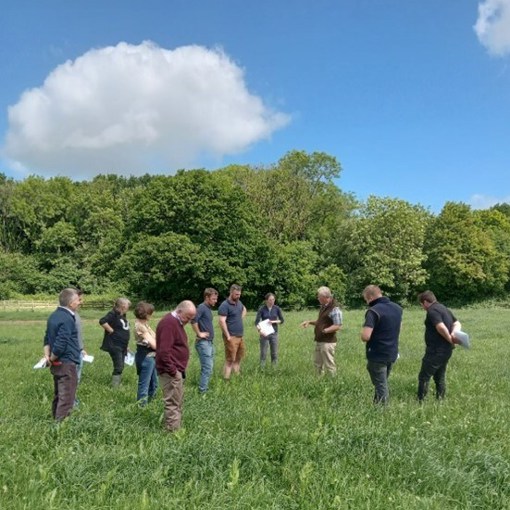PASTORAL is a collaboration between Innovative Farmers, the University of Edinburgh and agricultural data consultants Environment Systems, looking at improving pasture management using satellite imaging and computer modelling to monitor biomass, predict grass growth and produce carbon budgets.
As the first stage of research draws to a close, we talk to three farmers about the experience of taking part and what issues they hope improved pasture management will address in the future.
Organic beef herd, Somerset
John Ker runs a 47/ha organic beef farm, Kittisford Barton Farm, in Somerset. Typically, he and his dad operated by “looking rather than recording” pastures, mostly using a set stocking system. More recently they started to look at how they could improve grazing efficiency, to improve margins, and counteract impacts associated with the climate crisis, more unpredictable weather patterns for example.
What’s gone well?
“It’s really easy to take the data into consideration so we can make better decisions and forward think, especially around predicted growth in 2, 4, 6 weeks’ time. It’s definitely helped us think through when to move stock – we can make decisions about what grazing is available.”
What could be improved in future developments?
“The satellite data comes through weekly, which isn’t really quite frequent enough.”
What’s been the biggest change?
“As a result of being part of project, we’re now a hybrid between mob grazing and set stock grazing.”
Grass fed sheep and beef herd, Wiltshire
James and Katie Allen have 250 sheep and 50 cows at Great Cotmarsh Farm in Wiltshire. With a focus on agroecology, they wanted a whole farm picture to help judge how often to move livestock, and to where. With a good understanding of tall grass grazing, measuring hadn’t really been part of their farm practice – “tall grass grazing doesn't really suit plate meter reading”, says James.
What’s gone well?
“Rather than measuring grass growth by eye, we can get data from the satellites and measure the actual amount of grass and dry matter in each field. It’s meant we can predict and adjust our grazing, depending on the weather in particular.”
What could be improved in future developments?
“I’d be really keen to integrate this with other farm management tools, so I don’t keep flitting between different tools and apps.”
What’s been the biggest change?
“Having a bird’s eye view of the pastures to see how the grass is growing. I get a view of the farm as a holistic unit at the same time, every week.”
Regenerative farming with livestock, Leicestershire
David Clarke runs a 154/ha farm in Upton, southwest Leicestershire with his wife and son. They have 140 dairy cows and 150 Romney breeding sheep. 70% of their cow’s milk is used to produce cheese, so “what the cows graze becomes much more important – more diversity in what the cows eat gives us more diversity in flavour of the cheese.”
What’s gone well?
“Working with Tara [Dr Tara O’Neill] from Environment Systems has been interesting. She’s come to the farm several times and measured the biomass to check that it’s consistent with the satellite data.”
What could be improved in future developments?
“I can see how adding weather patterns to a future version would really help predict costly forage shortages. That would have been beneficial in last year’s drought. I couldn’t stop it being so dry, but if I’d had this information, I would have taken more whole crop and saved quite a lot of money over the winter.”
Where do you see use of satellite data being applied in the future? “Targeting inputs and identifying poor patches in fields – you might even notice patches that are always poor that you could supplement in some other way. On a national scale, as the climate changes, you could map changes across large areas. I can see potential in wildfire prevention and management, for example.”
Find out more
For more about the science of PASTORAL, see our interview with Dr Iain Cameron on 'How data can help farmers make smart decisions about grazing management'.
To find out more about PASTORAL, see envsys.co.uk/pastoral/
